PHOTOVOLTAIC SOLAR COOKING
WITHOUT BATTERIES
WITH PTC CERAMIC HEATERS
General summary of the documentation:
- Home
- Presentation of the cooker
- Design of the cooker
- 1 - Building and using a cooker
- 2 - Building a cooker: appendices
- 3 - Theoretical presentations
- 4 - Technical information
- 5 - Photovoltaic panel supports
- 6 - Automation of PTC ceramics
- 7 - Photovoltaic solar water heater
- 8 - Library
- Who are we?
the parts shown in grey are still under construction.
Chapter 1 A charger for telephones and USB lamps
When the collector is not being used for cooking, or when there is not enough sunlight, it can be used to recharge mobile phones, or 'USB lanterns', or external back-up batteries for mobile phones.
Two methods are available:
1- a conventional method, using a charge regulator, a small 12-volt lead-acid battery, and then a conventional "12V" mobile phone charger .
2- a lighter method, using only a "Direct Current Converter".
The DC converter is a small, fully encapsulated electronic component that accepts a variable DC supply voltage, generally between 8 and 50 volts, and produces a voltage of 5 volts identical to that of the chargers connected to the mains.
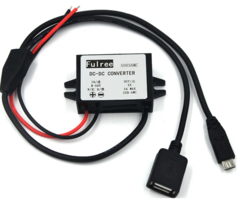
They are available on the Net under various names: power converters, voltage step-down converters, buck converters, etc. There are many different models, so check the specifications carefully. The "48V-24V-12V to 5V" models generally accept all voltages between 48 and 8V.
A mini installation
The converter should be connected to the output of the three-position switch on the cooker control panel (position I: to the cooker; position 0: zero; position II: to other uses), making sure that the + and - poles are correct..
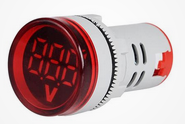
The user will always want to use the electricity supplied by the panel "to the last drop", but the converter still requires a minimum voltage. A good practice is to have a small voltmeter, either electronic or with a needle, and to determine a threshold below which the inverter should not be used, for example 8 V after the converter has been connected.
The voltmeter and converter could be installed on a plywood plate on which the appliances to be recharged could also be placed.
External batteries
Also known as back-up batteries, these are sophisticated components which, in addition to the battery itself, include a Battery Management System to manage battery charging, cell balancing, discharging, and so on. So it's best to buy a good quality external battery.
As a precaution (perhaps superfluous), it is preferable a priori to charge a phone from the external battery, rather than directly from the DC DC converter, as the current delivered by the battery may be of better quality than that from the converter. What's more, the external battery gives users more freedom to use the stored energy as they wish.
'USB' lanterns
These have a lithium battery that provides several hours of lighting, and can be recharged in the same way as a mobile phone.
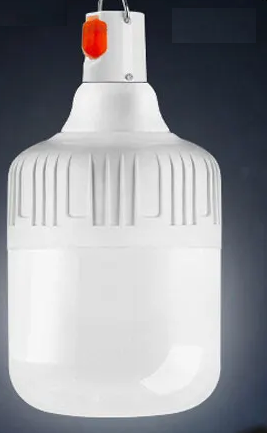
Chapter 2 Cooking and heating
What is cooking?
Among the various definitions of cooking, we can say that cooking is the act of subjecting food to a certain temperature so as to make it easier to assimilate.
"It breaks down starch molecules into more digestible fragments, it "denatures" protein molecules so that their amino acid chains are broken, and digestive enzymes can attack them more easily. And heat physically softens food. This makes them easier to digest, and even if the contents are no more calorific, the body needs fewer calories to assimilate them."
This is Dr Wrangham's thesis, set out in his 2009 book "Catching Fire: How Cooking Made Us Human", which was the subject of an article in The Economist (http://www.economist.com/node/13139619). "Cooking and other forms of food preparation are decisive for humanity: it is the fundamental element of evolution that underpins all the others that have set humanity apart."
Heat loss and the leaky bath.
Obviously, the bigger the leak, the longer it will take to fill the bath; the longer it takes to fill the bath, the more water will be wasted. If you're only interested in the time it takes to fill the bath and the leak is significant, "all you have to do is turn the tap on tighter"; if you're interested in overall water consumption, you'd be better off reducing the leak. When it comes to cooking, replacing the water in the bath with heat energy is strictly the same; there is always heat loss. If they are high, for example if you boil a pan of water without a lid, it will take longer to reach boiling temperature, and the total amount of thermal energy required will be very high, much of it being wasted. If the cooking vessel is insulated, losses are significantly reduced.
From a thermal point of view, cooking can be considered a war lost in advance, since everything (container, contents, etc.) will eventually return to the ambient temperature level, but it is a war in which every battle must be won, since the desired temperature level must be reached in order to cook the food.
Cooking and temperature levels.
All things being equal, successful cooking depends on the temperature level and the cooking time. For example, it takes longer to cook potatoes in water at 100°C than in oil at 170°C; or it takes longer to cook ham overnight at 60°C than a steak on the barbecue. At first glance, we can distinguish three levels of temperature:
- cooking in water at 100°C,
- cooking in an oil bath at 170°C
- grilling, at a higher temperature.
Because of the technology of the ceramic heating elements, the last two cooking modes are not accessible to the cooker presented here; nor will we look at low-temperature cooking, only cooking at 100°. The reference figure of 100°C is provided by physics; when the temperature of water reaches 100°C, and if we continue to supply it with thermal energy, the water is transformed into steam which escapes into the environment, but its temperature will not exceed 100°C even if it boils vigorously. Once the water has reached its vaporisation point, there's no point in continuing to heat it: the energy input should only compensate for the losses (of course, if the bath leaks a lot...).
The benchmark figure of 100°C applies to both water-bath cooking (potatoes and other foods) and braising, which is defined here as cooking without the addition of liquid, with the food cooking in the water it contains. From a physical point of view, there is no difference between cooking in a water bath and braising.
However, the benchmark of 100°C needs to be adjusted. The vaporisation of water at 100° is valid when the water is at atmospheric pressure, which is about 1 bar (1013 millibar) at sea level, or about 1 kg per cm². This is the weight of the column of air above our heads. Physics teaches us that if water is subjected to higher pressure, for example if it is enclosed in an enclosure such as a pressure cooker, it will only turn to steam at a higher temperature. In conventional pressure cookers, the pressure is set by the valve at 0.5 bar above atmospheric pressure, corresponding to a temperature of 110°C; in Lagostina pressure cookers, the pressure is set at 1 bar, giving a temperature of 120°C.
Higher temperatures mean faster cooking, as mentioned above. And the instructions clearly state that you should reduce the heat so that the valve only whispers: there's no need to make it whistle.
Physics also teaches us that if water is subjected to a pressure lower than 1 bar, it vaporises at a lower temperature. This is what happens when you climb to a higher altitude: the air column is lower, the pressure lower, and the water will never rise above a certain temperature. Atmospheric pressure also varies according to the weather, but these small variations are completely outside our scope.
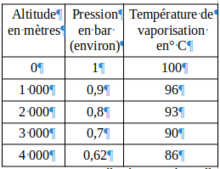
as a function of altitude
The Norwegian kettle.
All these notions of insulation, temperature and cooking time lead us, of course, to the Norwegian kettle, which Wikipedia describes as follows: "The Norwegian kettle (or fireless cooker, insulation cooker, wonder oven or self-cooking appliance) is a method of finishing cooking food by placing it in a container that is itself contained in an insulating receptacle: after being heated in the traditional way, but for less time than the usual cooking time, the food can finish cooking on its own, without further expenditure of energy. Contrary to what the name suggests, it's not necessarily a cooking pot, and it's not certain that it's of Norwegian origin."
The photovoltaic solar cooker proposed in this documentation is a Norwegian pot. Once the food has reached temperature, simply remove the power supply. See, for example, the cooking of Dahl coral lentils, in the presentation of the cooker: once the temperature had reached 100°C, and after removing the power supply, the cooking continued in a Norwegian pot, with the temperature still at 90°C after half an hour.
By connecting two cookers to a single solar panel, and operating them alternately, the overall efficiency of the installation is significantly increased.
Heating up and maintaining temperature.
It's important to distinguish between the two phases of cooking: heating up and temperature maintenance.
For the first phase, which requires the most thermal energy, the cooker is at the back of the pack compared with other cooking methods, given its low power: 200 W available under 800 W/m² of sunlight with a 350 W peak panel, compared with the usual 1000W or more available from gas, electricity or wood. Even with losses of 40 or 50% for the usual cooking methods, the playing field is uneven. But then when it comes to maintaining temperature, given the insulation, the cooker is well ahead of the pack, especially when cooking in a Norwegian pot.
Boiling and braising
Boiling refers to cooking food immersed in a volume of water. Braising refers to the cooking of food without the addition of liquid, the water contained in the food being sufficient to ensure that it cooks without "sticking" to the bottom of the container. Physics teaches us that, apart from a few very marginal exceptions, water is the body that requires the most thermal energy per unit of weight. In other words, there is nothing more difficult to heat than water.
When it comes to cooking with water, you have to heat the water and heat the food, for example tubers. The cooker is not well placed for this type of operation, or the cooking water has to be conserved for several successive cookings. In the case of braising, the cooker is much more at ease, even if the food often contains 80% or more water; at least it's liquid that's part of the cooking process, not thrown away at the end.
About the cost of the cooker;
• - Conventional electric heating elements require a correctly regulated current. As the current delivered by photovoltaic panels is highly variable, it has to be stored in batteries, with a regulator at the input and an inverter at the output.
• - Ceramic resistors can withstand wide variations in current. The cooker proposed here therefore needs neither a regulator, nor a battery, nor an inverter. It consists solely of ceramic resistors (which are ridiculously expensive) and switches. The laws of electricity are scrupulously respected, but given the self-regulation of the ceramic resistors, there will never be a burn-out.
As a corollary, if there's no sun, the cooker won't work, and you'll have to go back to the old cooking methods.
The cost of the cooker proposed here is therefore intrinsically lower than that of any other photovoltaic cooker; given the laws of physics and the current state of the art, it's impossible to get any more minimalist: solar panel, switches and ceramics.
About the price
As for the price in the context of unit or small series production, this is beyond the scope of the "cuisson-solaire-photovoltaique.org" team, which limits its activity to the development of the cooker and the provision of manufacturing instructions in an artisanal context as close as possible to the users...
Chapter 3 About photovoltaic collectors
The EnR Photovoltaic guide is a major source of information. Only a few useful reminders are provided here.
Some main characteristics
For a panel, we can distinguish two groups of characteristics, both of which are of interest: the STC Standart Test Condition characteristics, measured in 1000 W per m² of sunlight, which is in practice the maximum possible sunlight, and the NOCT Normal Operating Cell Temperature characteristics, measured in 800 W per m² of sunlight, which are closer to field conditions.
In reality, "good sunshine" means somewhere between the two. STC characteristics are more flattering than NOCT characteristics; on sales literature, retailers emphasise STC characteristics.
Here are some indicative values for a panel measuring 1.65 x 0.99 m, of average quality, used as a reference panel for our solar cooker.
STC characteristics, at 1000 W /m2 for our reference panel 280W peak:
a - Without extracting power:
- Open circuit voltage: when the panel is exposed to the sun but no energy is being extracted, we can measure a voltage between the two terminals of the panel, known as the open circuit voltage Uco = 39.9 V. Note that, even on very cloudy days, there is an open-circuit voltage of around 34 V, - but there is no current, and therefore no power.
- Short-circuit current: this time, by connecting an ammeter (of a suitable calibre!) between the two terminals of the panel, we create a short-circuit, and the ammeter measures the current flowing through it: Icc = 9.35 A
b - Extracting the maximum power at the Maximum Power Point
- Voltage at Maximum Power Point, when energy is drawn: Umpp = 31.1 V
- Current at Maximum Power Point: Impp = 9A
- The peak power is therefore :31.1 V * 9A = 280 Watt
If we want rounded figures (upwards) that are easy to remember, summarising the characteristics of our reference panel as presented by the retailers, we can use: 300 W Max/ 10 Amps Max/ 40 Volt Max;
NOCT characteristics, at 800 W, for our reference panel :
Nominal power Pmpp = 207 W
Open circuit voltage Uco = 36.4 V
Short circuit current Icc = 7.57A
Voltage at Maximum Power Point Umpp = 28.4
Current at Maximum Power Point Impp = 7.29 A
The electrical characteristics of a photovoltaic panel are well defined by the network of Intensity/Voltage curves, see Part 3 Theoretical presentations. Panel dealers are reluctant to supply these curves, and those that are published are very often wrong (sometimes they are the same curves for all the panels from the same dealer...).
Some specific characteristics of photovoltaic panels
the output of a photovoltaic panel depends on the amount of sunshine AND the load applied to it
When you're used to using grid electricity, you assume that the grid supplies the electricity you need, in terms of quality and quantity... In the case of photovoltaic electricity, the panel's optimum output varies according to whether the load is more or less suited to its current capacity. It is the regulation of the cooker that is responsible for achieving this match, by implementing the number of ceramics needed at a given moment to optimise the panel's output.
Ceramic resistors are very rustic objects, requiring very little fine-tuning; in particular, they self-limit their temperature to around 220°C, which eliminates any risk of burn-out.
Panel life
There are 10- and 25-year warranties for the panels (see more details in the GuideEnR). The reason for this seemingly long lifespan is that the panels are used in photovoltaic power plants, which are built using bank loans. It is therefore highly desirable for the panels to last longer than the loans... The quality of the panels can therefore be seen as a requirement of the banks (thank you!).
Panel yields
As far as we're concerned, this is a completely minor aspect: it doesn't matter to within a few per cent what the energy/sun yield is, what counts above all here is the price of the panel. But of course it's thanks to constant progress in research and industry that photovoltaic panels are now affordable for solar cooking.
Mechanical strength of the panels
The panels are surrounded by a metal profile, which is sufficient to hold them in place during transport, for some minor handling carried out with care, and then to place them on a support. However, the panel, which is covered by a sheet of glass, cannot withstand being warped (i.e. not being perfectly flat).
For our purposes, a panel must never be fixed directly from its frame; it must rest on a support along the entire length of its four sides. The support must therefore be resistant to warping, and if it's an adjustable support, it must rest on only three points, for example: on an axis, and on an adjustable stand so as to always define a plane. Four points, or a line and two adjustable supports, will never define a perfect plane, as the panel's protective glass plate, which has limited flexibility, will inevitably split along a diagonal.
Adjustable or fixed panel?
This question has already been addressed in the introduction to part 5, where a directional photovoltaic collector increases the thermal and financial efficiency of the collector-cooker pairing.
Choosing the panel location
This is a strategic decision, with a very strong psychological component: with traditional energies, the user makes fire where he wants, when he wants, and how he wants. Here, the sun is the master.
A fairly wise solution is not to rush into making a final decision straight away. It's only after a few weeks, months or a season that a compromise can be worked out; in the meantime, a fairground installation with a removable, adjustable support can be used to test different scenarios. And if the user isn't satisfied, the installation can be moved elsewhere.
Au sujet du prix des panneaux
A 280 W peak panel like the one used for the cooking examples or performance tests cost €100 in 2019; since then, standards have evolved towards greater power; at the end of 2023 in Namibia, you could buy a 550 W peak panel for €140. These figures should be set against the cost of buying bottles of gas for 10 years to do the same job: it's up to you to make your own calculations.
Below: the price of photovoltaic solar panels, published by
Our World in Data
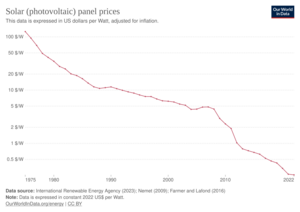
Chapter 4 About batteries
- A) Gel batteries, Introduction
- B) Gel batteries, reference documents
- C) Lithium batteries, Introduction
- D) Lithium batteries, some documents
- E) Charge controller and battery protector
- F) Batteries and danger
A) Gel batteries, Introduction
This section deals only with batteries as they are usually found in solar installations; gel batteries are lead batteries, they differ from the old lead-acid batteries in that the acid is encapsulated in a gel, which makes them sealed and maintenance-free. Some basic concepts are presented here, but most of the information should be gathered from the documents referred to in section B, for example.
Electricity storage and chemical reaction.
A battery does not store electricity, it stores chemical energy. When it is charging, the electricity causes a chemical reaction between the different materials contained in the battery, and when it is discharged, a reverse reaction occurs. This has a number of consequences.
- The chemical reaction has certain requirements, in particular it needs time for the chemical elements to combine correctly. A chemical reaction that takes place too quickly or under the wrong conditions leads to premature ageing of materials.
- the chemical reaction produces heat, both when charging and when discharging. However, this thermal energy can only come from the energy contained in the battery; the more powerful the charge or discharge, the greater the loss of energy and loss of efficiency; the result is also premature ageing of the battery, and even, in extreme cases, destruction and fire.
The C coefficient and Peukert's law
The available capacity of a battery depends on the amount of energy it contains, but it also depends on the speed of discharge: the faster the discharge, the smaller the total amount of energy available to the user.
Without attempting to give all the reasons for this phenomenon, it can be illustrated as follows: take three identical motor vehicles, each with 10 litres of petrol. If one is travelling at 60 kmh, it will cover more distance than the one travelling at 110 kmh, which will cover more distance than the one travelling at 140 kmh. And any driver of an electric vehicle knows full well that if they drive very fast, their battery will not go as far as if they drive slower.
When you read "100 Ah" on a battery label, it means that this 100 Ah of electricity will be available provided it is drawn regularly over a period of 20 hours, at a rate of 100/20 = 5 Ah.
This value of 20 hours, known as C20, is a convention between manufacturers, without which any indication of capacity would be fanciful.
The C20 value is valid for most gel batteries; there are also batteries stamped C10. The value of the C coefficient is one of the specific characteristics of a battery, and is normally shown on the label.
Note that the C coefficient for lithium batteries is 1. The C1 of lithium batteries is a great advantage over the C20 of gel batteries.
Consider a 100 Ah C20 gel battery that has been fully discharged.

100Ah C20
If you want to use 100 Ah in 1 hour rather than 20 hours, you need to increase the battery's capacity by a coefficient of 100/65 = 1.54. Each manufacturer indicates the performance of its batteries, but there don't seem to be any major differences from one gel battery to another.
Battery lifespan
Battery lifespan depends on a large number of variables, including
-number of cycles and depth of discharge at each cycle; for example :
500 cycles at 80% discharge
750 cycles at 50% discharge
1800 cycles at 30% discharge
- ambient temperature, for example
temperature 20° C: 12 years of foreseeable life
temperature 30°C: 6 years
40°C: 3 years
- repeated deep discharges can finish off a battery in a few months.
This is an extremely delicate point. What is a deep discharge? What is the risk of a deep discharge if the battery is used without adequate precautions? How can users be warned that they are approaching a deep discharge? It is best to consult the supplier documentation.
A battery's state of charge
At first glance, a battery's state of charge can be determined by measuring the voltage at its terminals. Here is a table based on data from two different manufacturers. The values vary somewhat, but there is agreement on the value of the voltage at 50% state of charge.
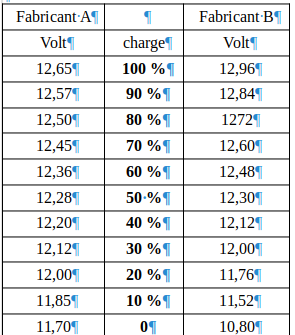
Calculation "on the corner of a table":
Sizing a battery for a 300 Watt electric cooker.
You want to cook for 1 hour with a 300 Watt electric cooker operating at 24 volts.
- Amperage required at 24 volts:
P (power, in Watt) = U (voltage, in Volt) x I (current, in Ampere)
P = UI; therefore I = P/U = 300/24 = 12.5 A
- Consumption: it is assumed that the cooker will run for one hour; the battery must be capable of supplying 12.5 A for one hour, i.e. 12.5 Ah, at 24 volts;
- Impact of coefficient C (Peukert's law): a mark-up of 1.54 is applied (difficult to negotiate)
12.5 Ah x 1.54 = 19.25 Ah
- Impact of the rate of discharge: in order to preserve the battery's life, we don't want to exceed a depth of discharge of 50% (somewhat debatable); we therefore need to double the battery's capacity; 19.25 Ah x 2 = 38.5 Ah at 24 volts.
- Conclusion: you need two 12 Volt/40 Ah batteries connected in series.
NB Once cooking is complete, the battery has to be recharged, whereas, with the sun shining, a cooker with PTC resistors can continue to work, provided the photovoltaic panel can be oriented. And, the icing on the cake, a cooker with PTC resistors can work perfectly well with a battery, and then without one. Or vice versa, of course.
B) Gel batteries, some reference documents
Here is an initial,very affordable, general document, published by batterie-solaire.com.
Another general document i is available from batteryuniversity.com
Next, here are three reference documents on gel batteries :
a) A document from guidenr.fr which devotes a section to lead-acid batteries.
b) A document from the manufacturer Power Sonic
Other documents are available at https://www.power-sonic.com/resource-center/
c) A document from a Victron Energy Victron Energy
https://www.victronenergy.com/support-and-downloads/technical-information provides access to a wealth of top-quality information.
We can't resist quoting the author of 'Energy without limits"'in his introduction on page 12:
'I like engines. When they go wrong you can listen, and look, and smell, and then take them apart. Parts can be
replaced, repaired or overhauled. Then put it all together again, and there they go!
With a battery you can’t do that. The battery is a secretive product. From the outside there is nothing to tell us
about its quality, possible aging or state of charge. Nor is it possible to take it apart. It could be sawn open, but
that ruins it for good and only highly qualified specialists could analyse the content and may be, in certain cases,
they could trace the cause of failure.
A battery, when it fails, has to be replaced. That’s it'
C) Lithium batteries, Introduction
Information on lithium batteries is not as complete or as well established as for conventional batteries. Perhaps this is because the field is new, and there is a diversity of lithium batteries? The introduction presents some basic concepts, but most of the information can be found in the documents referred to in section D).
Lithium batteries are more energy dense than lead batteries , but this aspect is not directly relevant to solar cooking.
The coefficient C (Peukert's law) is 1 ,
which is a definite advantage. A 100 Ah lithium battery will deliver 100 A in an hour. As with gel batteries, faster discharge will have an effect on the amount of energy available, but in our case this is not relevant.
The Battery Manager System
In the power range we're interested in, lithium batteries are equipped with a more or less sophisticated Battery Manager System, which constantly monitors the battery's state of charge or discharge, and all the elements necessary for its proper operation. Among other things, the BMS interrupts discharge before a critical voltage threshold for the battery (of the order of 2.7 to 3 volts per cell). See for example the presentation of the
Victron Energy battery management system (BMS).
In the event of a fault, the BMS can be replaced.
Note that even the small lithium batteries known as 'telephone back-up batteries' are equipped with a BMS: the operation of lithium batteries is too delicate to be left entirely to the user.
Lithium batteries are sophisticated devices, both in terms of hardware and electronics.
Lithium batteries are sophisticated devices, both in terms of hardware and electronics.
D) Lithium batteries, some reference documents
a) SAFT publications
A document on storage safety
and also: https://www.saft.com/energizing-iot/lithium-ion-batteries-use-5-more-tips-longer-lifespan
b) Tycorun
provides several hundred articles on lithium batteries,
batteries au lithium , for exemple:
https://www.takomabattery.com/discharge-current/
c) Power Sonic
publishes several documents on lithium batteries,, including
https://www.power-sonic.com/wp-content/uploads/2019/04/Lithium-Vs-lead-acid.pdf
E) Charge controllers and battery protectors
Charge controllers
If the battery is powered by photovoltaic panels, the charge controller must take account of the battery's state of charge, but it must also optimise the solar flux. There are two possible methods for this optimisation: MPPT or PWM; on the choice of one of the two, see the article
PWM ou MPPT ?
These are power electronic devices: the whole of the flux coming from the panel is manipulated to adapt it to the needs of the moment. See for example: Victron charge controllers https://www.victronenergy.fr/solar-charge-controllers .
In the case of small powers of 20 A or less, the charge controller also controls the discharge, and can even disconnect it if the battery charge is too low.
Battery protectors
For powers greater than 20 A, the discharge can (but there is nothing to indicate that it is compulsory...) be controlled by a battery protector. The aim is to avoid, among other things, deep discharges, which are a source of premature battery ageing. There are several types of protector, more or less sophisticated, with display screens, blue tooth systems for transmitting information and alarms, etc.... In the case of lithium batteries, battery protectors act in addition to the battery's internal BMS system.
-o-o-o-o-o-o-o-o-o-o-o
In conclusion, what are we to make of this commercial advert on one of the biggest international e-commerce sites?
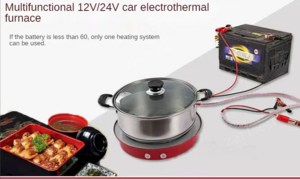
F) Batteries and danger
"The dangerousness of a container depends
- firstly on the amount of potential energy it contains, whether gas, steam, electricity in the form of chemical energy, or dynamite cartridges wrapped in paper.
- secondly, the speed with which this energy is released; a barrel of gas oil will not have the same effect as a can of petrol or a dynamite cartridge."
In the case of a battery, the sudden release of energy can come from a short-circuit caused, for example, by a metal tool that accidentally falls and remains on the two poles of the battery: the tool heats up and so does the battery, with the risk of fire and explosion. A person in the vicinity could be burnt or injured by the explosion, or by falling as a result of a reflex movement backwards, but their injuries will not be caused by electricity - there is no electrocution.
Note that direct current at 48 volts maximum is below the danger threshold, see part 4 of the documentation.
Lithium batteries are sensitive to ambient temperature (see documents above), and they heat up during charging and especially during rapid discharging; the risk of fire is far from negligible, hence the need for the Battery Manager System which, among other things, constantly monitors the battery temperature and can interrupt discharging if necessary.
Even the 3.5 V batteries used in our mobile phones are a potential source of danger. The instructions on the label state, among other things, that they should not be pierced: the tool used to pierce the battery would cause a short circuit between the various cells, resulting in a sudden release of energy and the risk of burns to the person concerned - but this would not be a case of electrocution.



